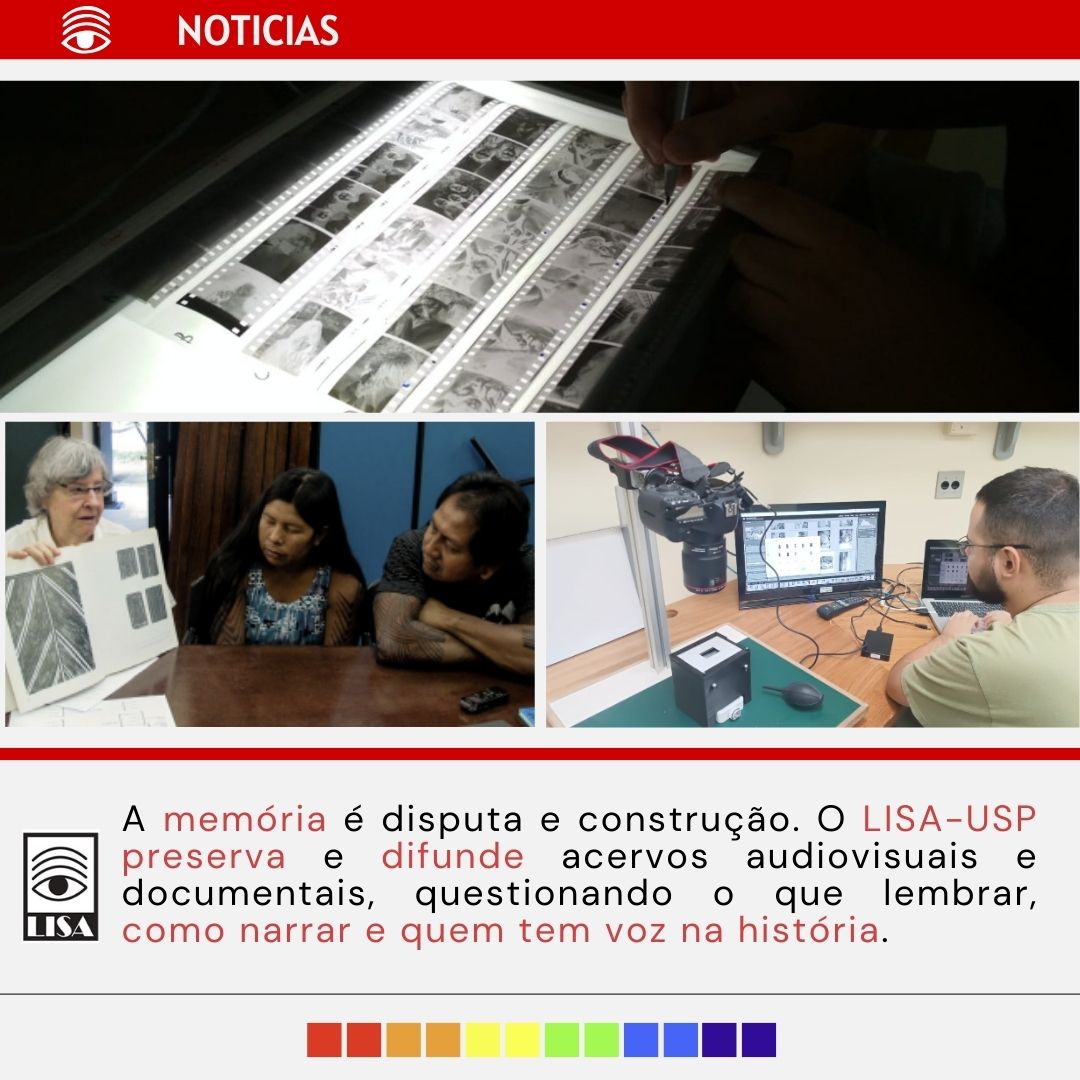Authorship: Maria Eduarda Mayumi Iryu de Melo Pimenta • LISA Scientific Journalism Scholarship
Art/Dissemination: Carlos Eduardo Conceição • LISA Scientific Dissemination Scholarship
Reviews: Sylvia Caiuby Novaes • Professor & LISA Founder | Vanessa Munhoz • LISA Communication
Published: 15/07/2025
Memory is more than a collection of records about the past—it is a field of disputes, affections, and meanings in constant transformation. Who can narrate history? What deserves to be remembered? Where and how are traces of the lived experience preserved? These are some of the questions that permeate the work of the Laboratory of Image and Sound in Anthropology (LISA-USP), which works to preserve, organize, and disseminate audiovisual and documentary collections related to anthropology and the humanities. More than simply preserving materials, LISA cares for narratives, subjectivities, and ways of seeing the world, making archival practice also an ethical and political exercise.
Since its founding in 1991 by Sylvia Caiuby Novaes, the Laboratory of Image and Sound in Anthropology (LISA) has established itself as an important center dedicated to the preservation and production of audiovisual materials related to the humanities. The laboratory boasts specialized infrastructure, including spaces for the careful storage of collections, an auditorium for exhibitions, and editing suites for the technical processing of archives. The collections include images, video recordings, and sound files from research with Indigenous populations and various other communities. In addition to preserving these records, LISA is constantly committed to ensuring that the content is accessible not only to the academic public but also to the communities involved, fostering a collaborative and respectful relationship with the keepers of these memories.
This ethical dimension is clearly reflected in the reflections of Leonardo Fuzer, responsible for the laboratory's collections. He notes that, "because it is a research environment, the LISA archives were acquired and documented primarily to serve academia, but I can't help but think about the potential impact they may have on the communities in which these images were produced. Photographs, drawings, and graphics produced by Indigenous populations are important research tools, but they are also records of people, objects, and rituals, representations of loved ones, the hard work, and the culture of these populations who, often, have little access to the spaces that hold the records of their memories."
Archival work at LISA involves a rigorous and careful technical process, carried out primarily by fellows from the Unified Scholarship Program (PUB). The first step is cataloging the materials, at which point each item in the collection—whether photographs, videos, or sound recordings—is identified, described, and entered into databases that allow for subsequent location and consultation. This process requires attention not only to the technical characteristics of the archives, but also to the production context and the information accompanying each record.
Next, the materials undergo sanitization, an essential step for the physical preservation of the original media. Photographs, tapes, and documents are manually cleaned with appropriate materials, ensuring that fungus, dust, or other impurities do not compromise their durability. Finally, the collections are digitized, a process that requires specific equipment and technical knowledge to convert the physical records into high-quality digital files. This step aims not only at conservation but also at expanding access, allowing the content to circulate in digital environments without compromising the originals.
For those who experience this process in the laboratory, the learning goes beyond the technical aspect. Luísa Kei, a PUB scholarship recipient, reports that "the work here makes us understand that when you pick up a photo or document, you're not just dealing with an object, but with a story, a memory that needs to be cared for responsibly, because it has not only a cultural and social dimension, but also a distinctly political one, which elevates the debate on the (re)signification of items and collections." This direct contact with the materials not only develops technical skills but also raises awareness of the symbolic, historical, and emotional value of the collections.
All this work results in the collections being made available on the LISA website, where a significant portion of the material can be accessed by the public. Digitization allows images, videos, and sounds to circulate beyond the physical shelves, expanding the possibilities for research, memory, and reconnection with the stories contained therein. By making its archives accessible online, LISA reaffirms its commitment to an open archival practice that values giving back to the communities involved and understands access as a fundamental part of preservation.
Despite the continuous effort and dedication of the teams, archival work at LISA faces significant challenges, especially regarding the availability of material resources. The conservation of fragile collections requires not only technical expertise but also specific supplies—such as gloves, brushes, acid-free boxes, blotting paper, and appropriate scanning equipment—which are not always readily available. Because many of the media are analog and already show signs of deterioration, the lack of these materials compromises the effectiveness of the cleaning and preservation steps. These constraints impose a slower pace of work, in addition to demanding from the team a combination of patience, creativity, and constant negotiation with institutional authorities to ensure the continuity of activities.
Regarding this scenario, Leonardo Fuzer reflects: "I think this situation affects many so-called 'small' collections like ours. Conservation work, more specifically, is ongoing and ever-increasing. After all, materials must be systematically treated, sanitized, digitized, and stored, while physical space constantly shrinks as new collections are added regularly. Infrastructure, consumables, and storage technologies (both analog and digital) are expensive, and the University, while recognizing the importance of this work, offers few opportunities for fundraising and invests little in hiring qualified personnel."
As mentioned, these activities are carried out by students participating in the Unified Scholarship Program (PUB) and other LISA programs. This integration is essential for the collection's sustainability, fostering the training of new researchers attentive to the importance of historical memory and document preservation. By involving students from different fields, the laboratory fosters an intergenerational dialogue that strengthens the link between the university's past and present.
LISA's work is part of a broader context of valuing memory and cultural practices in the university environment, contributing to the democratization of stories and voices often rendered invisible in official narratives. Through events, workshops, and exhibitions, the laboratory not only preserves archives but also serves as a dynamic space for the production and circulation of knowledge, where audiovisual heritage is constantly revisited and reinterpreted.
This formative and critical dimension of archival practice also emerges in the experience of those involved in the laboratory's daily activities. For Luísa Kei, a PUB scholarship holder, working at LISA was an exercise in rethinking the very meaning of memory and the role of the university: "Working here made me rethink what memory is, how it is accessed, and the role of the university. We realize that preserving is not neutral; it's choosing what will continue to exist in the future."
In this sense, LISA represents a strategic space for USP, integrating research, teaching, and outreach and strengthening the historical awareness of the academic community. By contributing to the construction of a plural and inclusive memory, the laboratory plays a fundamental role in understanding cultural and social dynamics, reaffirming the archive as a living field of disputes, affections, and meanings.



